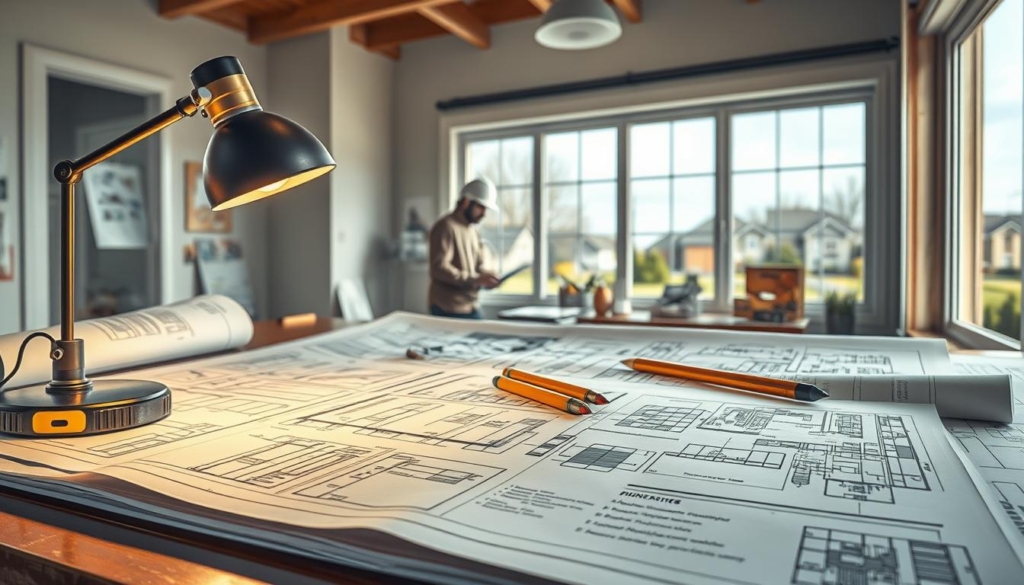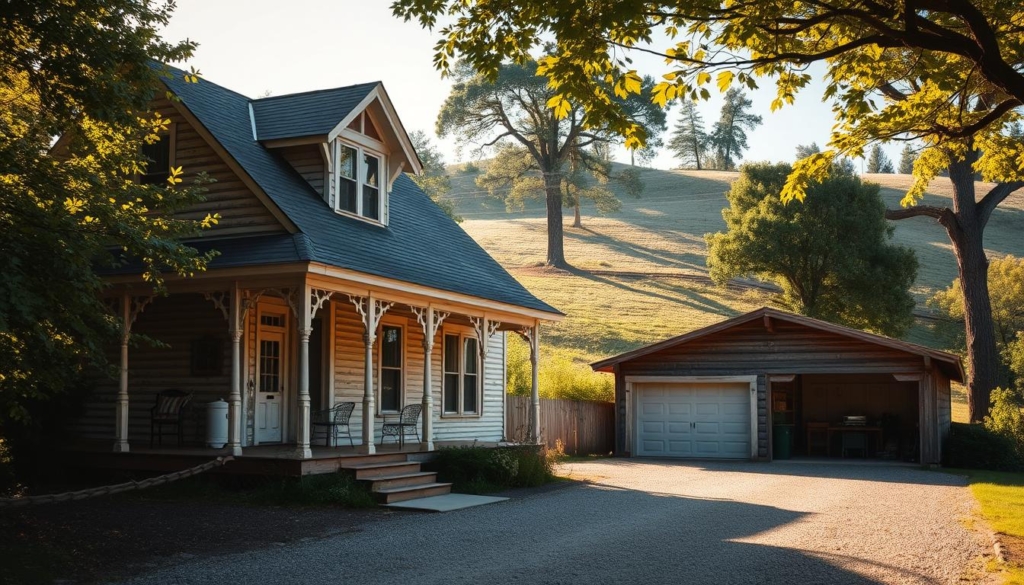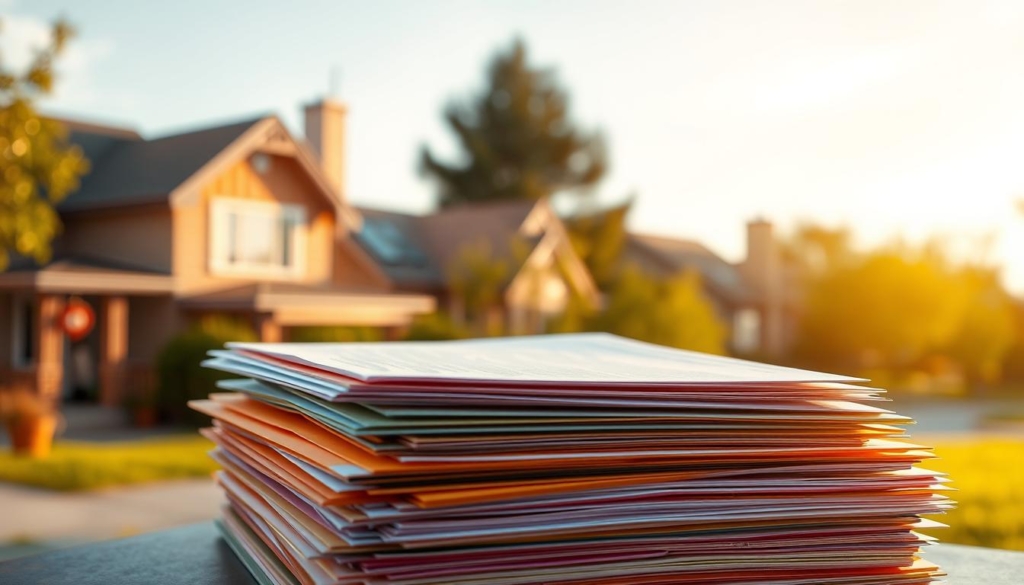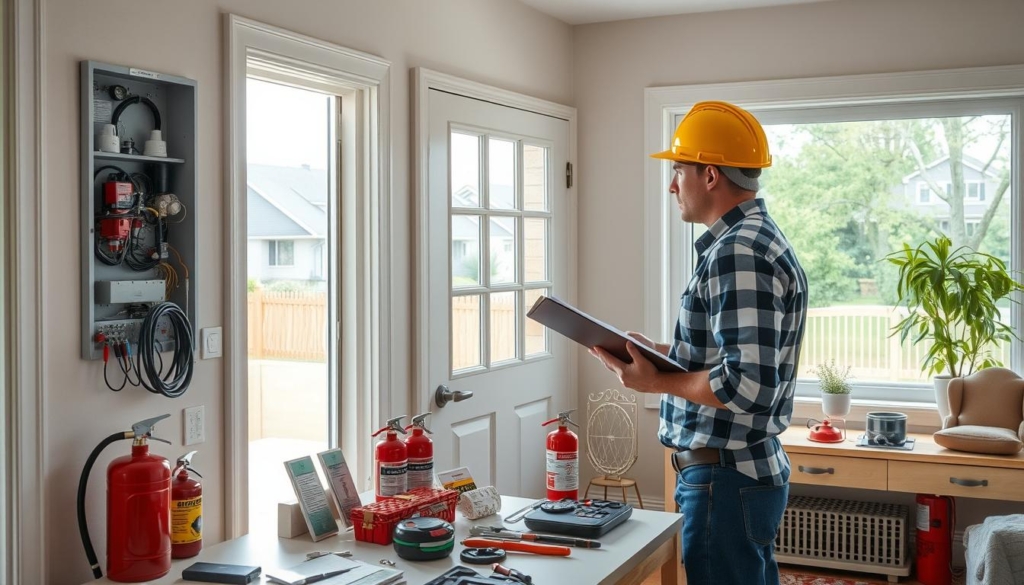Purchasing a property is one of the most significant decisions you’ll make. For first-time buyers and investors in Canada, understanding the real estate process requires clarity and confidence. This guide by New Homes Alberta simplifies the journey, offering actionable insights to help you navigate every stage.
Thorough preparation starts with knowing which details matter most during property visits. Industry professionals emphasize evaluating structural conditions, neighborhood dynamics, and ownership costs upfront. Pre-inspection reviews and mortgage pre-approval steps can save time and reduce surprises later.
At New Homes Alberta, our team supports clients with tailored guidance. Whether you’re exploring neighborhoods or comparing financing options, we prioritize transparency. Call (403) 305-9167 to discuss your goals with our experts.
This article breaks down critical considerations—from initial research to closing deals. You’ll learn how to assess home features, verify legal documentation, and align choices with long-term financial plans. Let’s build your path to informed decisions together.
Key Takeaways
- Prioritize structural and neighborhood evaluations during property visits.
- Secure mortgage pre-approval to streamline your budget planning.
- Verify legal documents and ownership history before committing.
- Consult professionals for pre-inspection assessments to avoid hidden costs.
- Align your purchase with long-term financial and lifestyle goals.
Understanding Your Home Buying Budget
Creating a realistic financial plan is the cornerstone of successful property ownership. Without clear boundaries, even desirable listings can strain your resources. Start by calculating your monthly income, existing debts, and emergency savings to define your comfort zone.
Pre-approval and Mortgage Considerations
Mortgage pre-approval gives buyers a competitive edge. Lenders assess your credit score and employment stability to determine borrowing limits. This step clarifies your price range and speeds up negotiations. Industry data shows pre-approved offers often close 17% faster in Canada’s fast-paced market.
Compare fixed and variable rates to align payments with long-term goals. New Homes Alberta partners with trusted lenders to simplify this process. Their experts help balance down payments with other priorities like renovations or retirement savings.
Estimating Closing Costs and Additional Fees
Budgeting goes beyond the listed price. Legal fees, land transfer taxes, and title insurance typically add 3-4% to your total. For a $500,000 property, this means $15,000-$20,000 in extra expenses.
Factor in utilities, strata fees (if applicable), and routine maintenance. Review recent sales in your target neighborhood to gauge realistic market expectations. Need personalized advice? Contact New Homes Alberta at (403) 305-9167 for transparent guidance tailored to Alberta’s housing landscape.
what questions to ask when buying a house
Curating essential details upfront prevents costly oversights in real estate transactions. A structured approach to gathering information ensures you address both visible features and hidden factors. New Homes Alberta recommends documenting priorities before touring any listing.
Establishing a Comprehensive Question List
Industry studies show 78% of buyers who prepare detailed inquiries report fewer post-purchase surprises. Focus on these core areas to build your checklist:
| Topic | Key Considerations | Data Source |
|---|---|---|
| Financials | Mortgage terms, closing costs, utility estimates | Seller disclosures |
| Condition | Roof age, HVAC updates, inspection results | Pre-inspection reports |
| Legal | Title status, permit history, boundary lines | Land registry |
| Market Context | Local price trends, recent comparable sales | Realtor associations |
Review strata documents for multi-unit properties to understand maintenance fees or pending assessments. One Alberta buyer recently avoided $12,000 in unexpected repair costs by verifying renovation permits through their agent.
Transparent sellers often provide repair histories and insurance claim summaries. Cross-reference these with independent inspections. New Homes Alberta’s team helps clients analyze this data, turning raw numbers into actionable insights.
Remember: Every property has a story. Your job is to uncover it through methodical inquiry. Book a consultation at (403) 305-9167 to refine your strategy with market-tested templates.
Evaluating the Property Condition
A property’s true value lies beyond its curb appeal—hidden details demand scrutiny. New Homes Alberta emphasizes systematic evaluations to uncover structural concerns and maintenance gaps. This proactive approach helps buyers avoid overpaying or inheriting expensive surprises.
Inspection Essentials and Red Flags
During viewings, focus on foundational elements first. Check walls for hairline cracks exceeding ¼ inch, uneven floors, or doors that stick. These may indicate settling issues. Inspect ceilings for water stains suggesting past leaks.
Moisture meters help detect hidden dampness in basements. One Alberta home buyer discovered mold behind drywall using this tool, saving $8,000 in remediation costs. Always ask sellers about flood history or insurance claims related to water damage.
Reviewing Recent Maintenance and Repairs
Request records for roof replacements, HVAC servicing, and electrical updates. A well-maintained furnace with annual inspections signals responsible ownership. Compare receipts with visible conditions—newly painted walls might hide unrepaired cracks.
| Maintenance Area | Ideal Documentation | Red Flags |
|---|---|---|
| Roof | Installation date + warranty | Missing shingles/granules |
| Plumbing | Pipe material records | Discolored water |
| Electrical | Panel upgrade permits | Flickering lights |
Use repair histories to negotiate the price. For example, outdated aluminum wiring could justify a $3,000 credit. New Homes Alberta’s agents help clients interpret these details, turning findings into strategic offers. Schedule a consultation at (403) 305-9167 to refine your inspection priorities.
Discussing Home Features and Inclusions
Every property sale comes with specific inclusions that directly affect its value and functionality for new owners. Overlooking these details can lead to disputes or unexpected costs. Industry data shows 63% of Canadian buyers discover discrepancies between verbal agreements and final contracts if items aren’t formally listed.

Clarifying What’s Included in the Sale
Light fixtures, built-in appliances, and parking spaces often stay with the home—unless stated otherwise. Request a written inventory from sellers. One Alberta family avoided replacing $4,500 worth of window coverings by confirming their inclusion upfront.
| Feature | Impact on Value | Negotiation Potential |
|---|---|---|
| High-end appliances | Adds $3,000-$8,000 | Often non-negotiable |
| Detached shed | Increases utility by 12% | May be removable |
| Smart home systems | Boosts appeal by 19% | Possible upgrade credit |
Structures like pergolas or fences typically remain unless excluded. Verify municipal permits for permanent installations. Sellers sometimes remove items they consider personal property—like antique chandeliers—if not specified in the agreement.
New Homes Alberta helps clients document these details through customized checklists. Their team identifies cost-saving opportunities, like transferring warranties for recently replaced roofs. For tailored strategies, call (403) 305-9167 to align your budget with reality.
Inquiring About Renovations and Repairs
Renovations can boost a property’s appeal, but their execution determines lasting value. Nearly 41% of Canadian buyers prioritize updated systems over cosmetic changes. Confirming upgrade quality helps avoid costly repairs and ensures fair pricing.

Details on Recent Upgrades
Request invoices and permits for all major improvements. A kitchen remodel completed by licensed contractors adds 8-12% to resale value versus DIY projects. Compare these examples:
| Upgrade Type | Value Impact | Documentation Needed |
|---|---|---|
| Electrical Rewiring | +5% Market Price | ESA Certificates |
| Roof Replacement | +9% Buyer Interest | Installation Warranty |
| Basement Waterproofing | Reduces Risk by 68% | Contractor Guarantees |
Unpermitted work could lead to municipal fines. One Edmonton seller reduced their asking price by $14,000 after failing to provide bathroom renovation approvals.
Warranty and Professional Work Confirmations
Transferable warranties on HVAC systems or windows protect new owners for 3-10 years. Verify these points:
- Licensed contractor signatures on repair invoices
- Expiration dates for material guarantees
- Municipal inspection records for structural changes
Proper documentation preserves 92% of renovation value versus undocumented projects. New Homes Alberta’s team reviews these details during offer preparations. Contact them at (403) 305-9167 to assess upgrade legitimacy in your target property.
Understanding the Age and Maintenance of the House
A home’s age directly impacts its value and future costs. While older properties charm buyers with character, they often require more meticulous inspections. Focus on verifying maintenance timelines for critical systems like roofing, plumbing, and electrical wiring.

Industry data reveals 62% of Canadian homeowners face unexpected repair costs within five years of purchase. Prioritize these three areas during evaluations:
Assessing the Roof, Windows, and Structural Integrity
Roof age: Asphalt shingles typically last 15-25 years. Check for curling edges or missing granules—signs of wear costing $8,000-$15,000 to replace. Request installation dates and warranty transfers.
Window condition: Drafty or cracked frames increase heating bills by 10-15%. Look for condensation between panes, indicating seal failures. Energy-efficient upgrades often pay for themselves within 7 years.
| Component | Lifespan | Replacement Cost Range |
|---|---|---|
| Roof | 15-30 years | $5,000-$25,000 |
| Windows | 20-40 years | $300-$1,000 per unit |
| Foundation | 50+ years | $10,000-$40,000 |
Red flags include uneven door frames or horizontal foundation cracks wider than ¼ inch. One Alberta buyer negotiated a $12,000 price reduction after discovering outdated aluminum wiring during their inspection.
“Maintenance records are the property’s medical chart—they reveal its history and predict future issues.”
Review repair invoices for water damage fixes or pest treatments. Sellers who invested in copper piping or upgraded insulation demonstrate proactive care. Connect with New Homes Alberta at (403) 305-9167 to analyze maintenance histories against local market standards.
Asking About Utility Costs and Ongoing Expenses
Understanding recurring household expenses is crucial for long-term financial stability. Utility bills and maintenance fees can vary widely between properties, directly affecting your monthly budget. Proactive buyers analyze these costs alongside mortgage payments to avoid affordability surprises.
Estimating Monthly Bills and Energy Efficiency
Start by requesting 12 months of utility statements from the seller. This reveals seasonal patterns—like higher winter heating costs in Alberta’s climate. Compare these figures with similar-sized homes in the area using municipal averages or realtor-provided data.
- Review hydro, gas, and water bills for usage trends
- Check ENERGY STAR ratings on appliances and windows
- Calculate potential savings from smart thermostats or insulation upgrades
Energy-efficient properties often cost 15-20% less to operate annually. A Calgary study showed homes with upgraded insulation reduced heating expenses by $480 per year. Always verify if recent renovations included efficiency improvements eligible for provincial rebates.
Factor in municipal waste collection fees and landscaping costs. New Homes Alberta advises clients to allocate 1.5% of the property price annually for routine maintenance. Their team provides localized cost comparisons—call (403) 305-9167 to access these resources.
“A $300 monthly utility difference equals $36,000 over a decade—enough for a kitchen remodel or college fund.”
Questions About Home Insurance
Home insurance is a critical safeguard that protects your investment from unexpected events. Over 38% of Canadian buyers underestimate how property features and past claims influence coverage costs. Addressing this early prevents coverage gaps and premium surprises.
Insurance Premiums and Claims History
Request five years of insurance records from sellers. Focus on water damage claims and roof repairs—these often increase annual premiums by 12-18% in Alberta. Older electrical systems or outdated plumbing may also raise costs due to higher risk assessments.
| Factor | Premium Impact | Preventive Action |
|---|---|---|
| Roof Over 15 Years | +22% Average | Request inspection report |
| Basement Flood History | +35% Risk Surcharge | Install sump pump |
| Copper Wiring Present | -8% Discount | Provide electrician certificate |
Compare quotes from three providers minimum. Bundling auto and home policies often saves 15% annually. One Edmonton buyer reduced their rate by $410/year through strategic provider negotiations.
“A home’s insurance history reveals its vulnerabilities. Always cross-reference claims with inspection findings.”
Discuss transferable warranties on recent upgrades like water heaters. These can lower initial fees while ensuring continuous coverage. For personalized rate comparisons aligned with Alberta’s real estate standards, contact New Homes Alberta at (403) 305-9167.
Assessing the Neighborhood and Area Quality
The character of a neighborhood shapes daily life as much as your home‘s walls define its structure. Beyond square footage or price, the surrounding area influences convenience, safety, and long-term satisfaction. New Homes Alberta encourages buyers to evaluate these factors with the same rigor as property inspections.

Community Vibe and Safety Considerations
Visit the area at different times—mornings, evenings, and weekends—to gauge noise levels and social dynamics. Check municipal websites for crime statistics or community initiatives. Well-maintained parks and active local associations often signal engaged residents.
Look for indicators like street lighting quality and pedestrian traffic. Alberta neighborhoods with walkability scores above 70 typically see 23% faster home value growth. Chat with locals at coffee shops or markets to gather unfiltered insights about the area’s strengths and challenges.
Local Amenities and Future Developments
Compare proximity to schools, healthcare facilities, and transit routes. Use this framework to prioritize needs:
| Amenity Type | Ideal Distance | Impact on Value |
|---|---|---|
| Public Transit | Under 500m | +7-12% |
| Grocery Stores | Under 1km | +5% Convenience Premium |
| Future LRT Stations | Planned Nearby | +18% Projected Growth |
Research municipal zoning plans for upcoming projects. A proposed commercial complex could boost convenience but increase traffic. New Homes Alberta’s team provides updated development maps—call (403) 305-9167 to assess how regional changes might affect your buyer experience.
“A well-chosen location doesn’t just meet today’s needs—it adapts to tomorrow’s possibilities.”
Inquiring About Local Taxes and Fees
Local taxes and fees significantly influence long-term homeownership costs, yet many buyers overlook these details during budgeting. Beyond mortgage payments, municipal levies and annual assessments can reshape affordability. New Homes Alberta emphasizes reviewing these obligations early to align expectations with financial reality.

Municipal and School Taxes Overview
Property taxes in Alberta typically range from 0.5% to 1.5% of a home’s assessed value annually. Combined with school taxes, these fees often total $3,000-$8,000 yearly for mid-range properties. Request five years of tax statements to identify trends—some areas see 4-7% annual increases due to infrastructure projects.
| Tax Type | Average Cost | Payment Frequency |
|---|---|---|
| Municipal | $2,100-$5,400 | Monthly/Annual |
| School | $900-$2,600 | Annual |
| Utility Fees | $800-$1,200 | Monthly |
Visit municipal offices or online portals to access historical data. Discrepancies between current bills and past amounts may indicate upcoming rate adjustments. One Calgary buyer avoided a 12% budget shortfall by discovering planned roadwork surcharges during their research.
“Tax documents tell the story of a property’s financial footprint. Cross-reference them with regional development plans for accuracy.”
Factor these expenses into your 1.5%-5% closing cost estimate. For example, a $600,000 home could incur $9,000-$30,000 in upfront fees plus recurring taxes. New Homes Alberta’s experts provide localized breakdowns—call (403) 305-9167 to map your obligations against Alberta’s evolving tax landscape.
Emerging Safety and Inspection Concerns
A property’s safety profile often determines its long-term viability as a home. Undetected hazards can escalate repair bills or compromise livability. Proactive assessments during the inspection phase empower buyers to address risks before finalizing contracts.

Potential Hazards and Structural Issues
Structural cracks wider than ¼ inch, sloping floors, or musty odors signal deeper problems. Moisture intrusion behind walls often leads to mold growth—a health risk requiring $5,000-$15,000 in remediation. Outdated aluminum wiring increases fire hazards, while aging sewer lines risk backups.
| Hazard | Visual Indicators | Cost Impact |
|---|---|---|
| Foundation Shifts | Diagonal wall cracks | $8,000-$25,000 |
| Roof Deterioration | Missing shingles | $4,500-$12,000 |
| Plumbing Leaks | Water stains | $1,200-$7,000 |
Delayed assessments compound risks. Alberta insurers may deny coverage for pre-existing water damage or unpermitted electrical work. One Edmonton buyer reduced their insurance premium by 18% after proving upgraded plumbing met current codes.
“Early detection transforms risks into negotiable points during price discussions.”
Schedule professional evaluations within your inspection window to maintain negotiation leverage. New Homes Alberta connects clients with certified specialists—call (403) 305-9167 to prioritize safety without sacrificing time or budget.
Probing for Pest and Environmental Concerns
Unseen threats like pests and moisture can silently undermine a property’s value and safety. Over 27% of Canadian homeowners discover infestations or environmental damage post-purchase—issues often overlooked during initial viewings. Proactive buyers prioritize these checks to avoid inheriting costly repairs or health risks.

Identifying Past Infestations and Moisture Problems
Termites, carpenter ants, and rodents cause structural damage averaging $7,200 in repairs across Alberta. Ask sellers for pest control records and warranties. Look for frass (insect debris), hollow-sounding wood, or gnaw marks near baseboards during inspections.
Moisture issues like mold thrive in basements and attics. Musty odors or discolored drywall often signal hidden leaks. Remediation costs spike 42% if problems spread behind walls. Request documentation of past waterproofing efforts or dehumidifier installations.
| Pest Type | Common Signs | Average Repair Cost |
|---|---|---|
| Termites | Mud tubes, damaged wood | $3,800-$11,000 |
| Mice | Droppings, nesting materials | $200-$600 |
| Carpenter Ants | Sawdust piles, rustling noises | $1,000-$4,500 |
Environmental assessments should include soil tests for oil tanks or asbestos in pre-1980s homes. New Homes Alberta partners with certified inspectors to evaluate these risks. Their team reviews reports line-by-line, explaining implications in plain language.
“A single undetected termite colony can compromise floor joists within months. Always verify treatment histories before closing.”
Demand proof of clearance certificates after remediation work. Sellers must disclose known issues in Alberta—failure risks legal action. For thorough risk assessments tailored to local climates, contact New Homes Alberta at (403) 305-9167.
Exploring the Property’s Past and Seller’s Disclosure
A property’s history holds clues to its future demands—unearthing these details safeguards your investment. Seller disclosures provide critical insights into past repairs, ownership changes, and environmental factors. Transparent records help buyers anticipate maintenance needs and negotiate fair terms.
Understanding Reason for Sale and Historical Damages
Ask sellers directly about their motivation for moving. Relocation or upsizing often signals routine transitions, while vague answers may hint at unresolved property issues. Alberta law requires disclosure of material latent defects, but proactive inquiries uncover more nuanced concerns.
Review these key areas in disclosure documents:
| Disclosure Topic | Impact on Value | Disclosure Rate in Alberta |
|---|---|---|
| Water Damage History | -8% to -15% | 62% |
| Foundation Repairs | ±5% (Quality Dependent) | 48% |
| Electrical System Updates | +3% Marketability | 71% |
One Calgary buyer avoided $9,500 in mold remediation costs after discovering undisclosed basement leaks through inspection cross-checks. Always compare seller statements with municipal permits and contractor invoices.
“A property’s past isn’t just paperwork—it’s the roadmap for your ownership journey. Missing details today become budget drains tomorrow.”
New Homes Alberta analyzes disclosure packages to identify red flags like insurance claim patterns or permit gaps. Their experts explain how historical issues align with provincial building codes and market standards. For assistance interpreting seller documents, call (403) 305-9167.
Reviewing Legal, Title, and Warranty Considerations

Clear ownership documentation separates smooth transactions from costly legal battles. Over 23% of Alberta real estate disputes stem from incomplete title reviews or permit gaps. New Homes Alberta emphasizes three pillars of due diligence: verified paperwork, transferable protections, and municipal compliance.
Clarifying Ownership Documentation and Permits
Always request the title search report before finalizing any purchase. This document confirms legal boundaries, easements, and liens. One Edmonton buyer discovered a $14,000 utility lien during their review—resolved before closing through seller negotiations.
| Document Type | Purpose | Review Focus |
|---|---|---|
| Title Deed | Ownership Proof | Signatures, Encumbrances |
| Survey Certificate | Boundary Accuracy | Fence Lines, Structures |
| Renovation Permits | Work Legality | Dates, Inspector Sign-offs |
Warranties on roofs, windows, or HVAC systems often transfer to new owners. Check expiration dates and coverage limits. A Calgary family saved $6,200 on furnace repairs using the remaining 3-year manufacturer warranty included in their sale.
Major renovations require municipal permits—especially electrical or structural changes. Unapproved projects can lead to fines or mandatory demolition. New Homes Alberta’s team cross-references contractor invoices with city records to ensure compliance.
“Proper documentation review isn’t just checking boxes—it’s building a legal safety net for your largest investment.”
Consult real estate lawyers to interpret complex clauses or zoning restrictions. Their expertise often identifies risks hidden in dense legal jargon. For streamlined document verification aligned with Alberta’s regulations, contact New Homes Alberta at (403) 305-9167.
Engaging with Real Estate Professionals
Collaborating with skilled real estate experts transforms complex transactions into manageable steps. Their insights help buyers avoid pitfalls while maximizing value. Industry data shows 84% of Alberta purchasers who work with agents report higher satisfaction with their final agreements.
Questions for the Seller and Their Agent
Direct communication clarifies uncertainties and builds trust. Ask sellers about recent upgrades, neighborhood changes, or upcoming assessments. Agents should provide:
| Focus Area | Key Questions | Data Sources |
|---|---|---|
| Property History | Age of major systems? | Maintenance records |
| Market Context | Days on market? | MLS® comparables |
| Legal Status | Pending easements? | Title documents |
One Edmonton buyer negotiated a $7,500 credit after their agent uncovered unpermitted deck modifications during discussions.
Condo Buying Expertise and Co-ownership Details
Condos require specialized due diligence. Review bylaws for rental restrictions or renovation rules. Verify reserve fund health—underfunded associations often levy surprise fees.
| Consideration | Impact | Verification Method |
|---|---|---|
| Bylaws | Limits pet ownership | Strata documents |
| Reserve Funds | Prevents special assessments | Financial statements |
| Shared Costs | Affects monthly fees | Budget breakdowns |
Co-ownership agreements demand clear exit strategies. New Homes Alberta connects clients with legal advisors to draft fair terms. Their team simplifies the process through market-tested checklists.
Reliable agents save 11 hours weekly on paperwork and negotiations. They decode jargon, identify leverage points, and ensure compliance with Alberta’s regulations. For vetted professional referrals tailored to your home goals, call New Homes Alberta at (403) 305-9167.
Conclusion
Navigating the home acquisition journey requires balancing practical details with long-term vision. By focusing on budget alignment, structural evaluations, and neighborhood dynamics, buyers lay foundations for sound decisions.
Thorough reviews of maintenance records and legal documentation remain non-negotiable. These steps protect against hidden costs while ensuring your investment aligns with lifestyle priorities. New Homes Alberta’s comprehensive approach transforms complex processes into actionable steps.
Your diligence today shapes tomorrow’s living experience. Use the insights and checklists provided to verify property conditions, ownership histories, and local market trends. Quality research paired with expert guidance minimizes risks while maximizing value.
Ready to move forward with confidence? New Homes Alberta’s team offers tailored support at every stage—from initial walkthroughs to final paperwork. Call (403) 305-9167 to access professional resources designed for Alberta’s unique real estate landscape.





